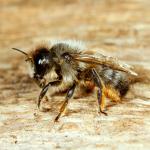Apis bryorum SCHRANK 1781
Widely distributed throughout Britain from the southern coast of England to northern Scotland (Golspie). However, it is undoubtedly decreasing in southern England. For example, the most recent record from Hampshire is 1983 (S R Miles),West Sussex in 1974 (M Edwards, pers. comm.), and for Surrey in 1973 (D Baldock, pers. comm.). Populations still exist on the extensive coastal dune systems of eastern Scotland, including those at Culbin (abundant in June 1982, pers. obs.), Newburgh, and Rattray Head. The species occurs throughout much of Eurasia, from Fennoscandia south to Iberia, and east to Iran and Siberia.
This species is not regarded as being of conservation concern, though its widespread decline, at least in southern Britain, indicates its status should be reviewed.
Coastal dunes and inland heaths.
Univoltine, late May to early August.
Nest burrows are reported to be excavated in the soil (Benno 1945) and in wood (Saunders 1896; Erlandsson 1955). The cell walls are known to be fashioned from rose and birch leaves (Saunders (1896) and Nielsen (1902) respectively).
Bramble (Rubus fruticosus agg.), common bird’s-foot-trefoil (Lotus corniculatus) and restharrows (Ononis spp.).
There are numerous published references to Coelioxys elongata, C. mandibularis, C. quadridentata and C. rufescens (Megachilinae) being cleptoparasites of this species.
Profile written:
Proofed: February 2012


